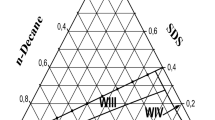Abstract
Rheology of the individual polymer solutions and complex polymer mixtures was studied in the temperature range from 30 to −20 °C. Based on the obtained data steady-shear flow properties and thermodynamic parameters of a viscous flow were calculated. Exploiting the flow parameters such as the flow behavior index it was demonstrated that addition of synthesized anionic polymeric surfactant—polyvinyl octanal (PVO) to the polyelectrolyte solution enhanced pseudoplasticity of the obtained liquids at low temperatures. Along with that, the anomalous behavior of the activation enthalpy and activation entropy as a function of temperature was observed for the polyelectrolyte solutions containing PVO. Thus, it was shown that relatively high initial values of ΔH A diminish sharply with an increase in temperature and TΔS A values decrease dramatically below 0 °C. The obtained results were in line with the concept of the critical temperature observed for the strongly associated polymeric systems in water–glycol mixtures. In the light of the findings it was assumed that specific interpolymer association occurs at low temperatures resulting in consequent increase in the values of apparent viscosity and pseudoplasticity of the studied polymeric liquids. It was also suggested that studied system is well suited for the formulation of the thickened aircraft deicing fluids.











Similar content being viewed by others
References
Robb ID, Stevenson P (2000) Interaction between poly(acrylic acid) and an ethoxylated nonionic surfactant. Langmuir 16(18):7168–7172. doi:10.1021/la000386r
Anghel DF, Saito S, Baran A, Iovescu A (1998) Interaction between poly(acrylic acid) and nonionic surfactants with the same poly(ethylene oxide) but different hydrophobic moieties. Langmuir 14(19):5342–5346. doi:10.1021/la9707888
Bogomolova A, Keller S, Klingler J et al (2014) Self-assembly thermodynamics of pH-responsive amino-acid-based polymers with a nonionic surfactant. Langmuir 30(38):11307–11318. doi:10.1021/la5031262
Talwar S, Harding J, Oleson KR, Khan SA (2009) Surfactant-mediated modulation of hydrophobic interactions in associative polymer solutions containing cyclodextrin. Langmuir 25(2):794–802. doi:10.1021/la803056e
Langevin D (2009) Complexation of oppositely charged polyelectrolytes and surfactants in aqueous solutions. A review. Adv Colloid Interfac 147–148:170–177. doi:10.1016/j.cis.2008.08.013
English RJ, Laurer JH, Spontak RJ, Khan SA (2002) Hydrophobically modified associative polymer solutions: rheology and microstructure in the presence of nonionic surfactants. Ind Eng Chem Res 41(25):6425–6435. doi:10.1021/ie020409s
Ya Li, Kwak JCT (2004) Rheology of hydrophobically modified polyacrylamide-co-poly(acrylic acid) on addition of surfactant and variation of solution pH. Langmuir 20(12):4859–4866. doi:10.1021/la036331h
Plucktaveesak N, Konop AJ, Colby RH (2003) Viscosity of polyelectrolyte solutions with oppositely charged surfactant. J Phys Chem B 107(32):8166–8171. doi:10.1021/jp0275995
Raffa P, Wever DAZ, Picchioni F, Broekhuis AA (2015) Polymeric surfactants: synthesis, properties, and links to applications. Chem Rev 115(16):8504–8563. doi:10.1021/cr500129h
Rumyantsev M (2013) Influences of co-solvent on hydrogen bond reorganization in ternary poly(vinyl alcohol) solutions. Eur Polym J 49:2257–2266. doi:10.1016/j.eurpolymj.2013.05.005
Rumyantsev M, Zelentsov SV, Gushchin AV (2013) Retardation effect in acetalization of poly(vinyl alcohol) with butyraldehyde. Eur Polym J 49:1698–1706. doi:10.1016/j.eurpolymj.2013.03.014
Awwadi FF, Willett RD, Peterson KA, Twamley B (2007) The nature of halogen···halide synthons: theoretical and crystallographic studies. J Phys Chem A 111:2319–2328. doi:10.1021/jp0660684
Rumyantsev M, Sitnikov NS, Somov NV (2015) Hydrogen-bond-assisted organocatalytic acetalization of secondary alcohols: experimental and theoretical studies. J Phys Chem A 119(18):4108–4117. doi:10.1021/acs.jpca.5b02102
Berger PA, Remsen EE, Leo GC, David DJ (1991) Characterization of acetal ring conformations in poly(vinyl acetal) resins using two dimensional nuclear magnetic resonance spectroscopy. Macromolecules 24(9):2189–2193. doi:10.1021/ma00009a008
Bruch MD, Bonesteel JAK (1986) Interpretation of the proton NMR spectrum of poly(vinyl butyral) by two-dimensional NMR. Macromolecules 19(6):1622–1627. doi:10.1021/ma00160a023
Hurst GA, Bella M, Salzmann CG (2015) The rheological properties of poly(vinyl alcohol) gels from rotational viscometry. J Chem Educ 92(5):940–945. doi:10.1021/ed500415r
Goddard ED (1994) Polymer/surfactant interaction—its relevance to detergent systems. J Am Oil Chem Soc 71:1–16. doi:10.1007/BF02541467
Trufakina LM, Kudeshova EG (2003) Rheological properties of the mixtures of semidiluted and concentrated solutions of polyvinyl alcohol and carboxymethyl cellulose. J Eng Phys Thermophys 76:535–539. doi:10.1023/A:1024704510811
Lodge TP, Muthukumar M (1996) Physical chemistry of polymers: entropy, interactions, and dynamics. J Phys Chem 100(31):13275–13292. doi:10.1021/jp960244z
Martinez F, Pena MA, Bustamante P (2011) Thermodynamic analysis and enthalpy–entropy compensation for the solubility of indomethacin in aqueous and non-aqueous mixtures. Fluid Phase Equilibr 308:98–106. doi:10.1016/j.fluid.2011.06.016
Searle MS, Williams DH (1992) The cost of conformational order: entropy changes in molecular association. J Am Chem Soc 114(27):10690–10697. doi:10.1021/ja00053a002
Wolfenden R (2003) Thermodynamic and extrathermodynamic requirements of enzyme catalysis. Biophys Chem 105(2–3):559–572. doi:10.1016/S0301-4622(03)00066-8
Tager AA (1974) Effect of solvent quality on the viscosity of flexible-chain and rigid-chain polymers in a wide range of concentrations. Rheol Acta 13:323–332. doi:10.1007/BF01520895
Acknowledgements
Features of the interaction of surfactants with alkyl methacrylates-containing copolymers were studied with financial support of the Russian Science Foundation (project No 15-13-00032). Synthesis of the HMPAA was carried out in Lobachevsky State University of Nizhny Novgorod and was financially supported by the Ministry of Education and Science of Russian Federation (agreement No.02.G25.31.0119).
Author information
Authors and Affiliations
Corresponding author
Rights and permissions
About this article
Cite this article
Rumyantsev, M., Savinova, M.V. Steady-shear rheology and activation thermodynamics of the interpolymer complex between nonionic polymeric surfactant and hydrophobically modified polyacrylic acid in propylene glycol–water mixture. Polym. Bull. 75, 17–30 (2018). https://doi.org/10.1007/s00289-017-2013-3
Received:
Revised:
Accepted:
Published:
Issue Date:
DOI: https://doi.org/10.1007/s00289-017-2013-3




